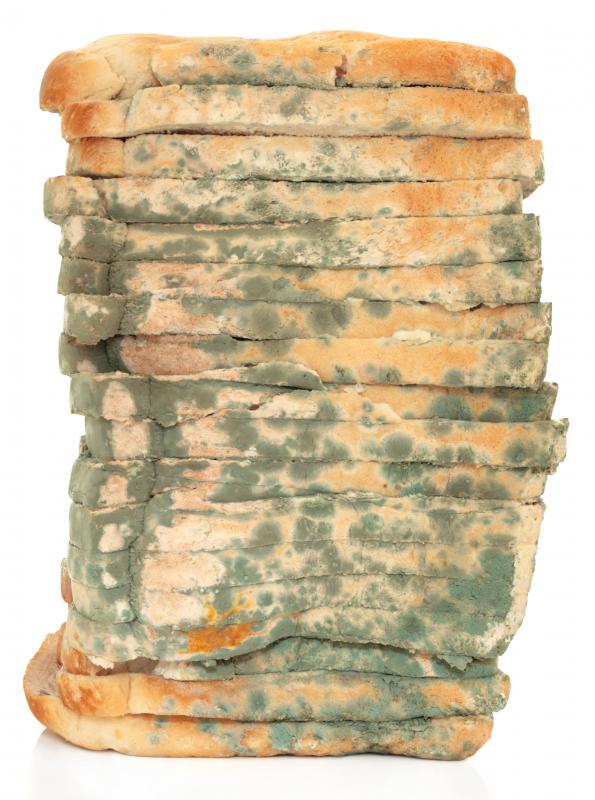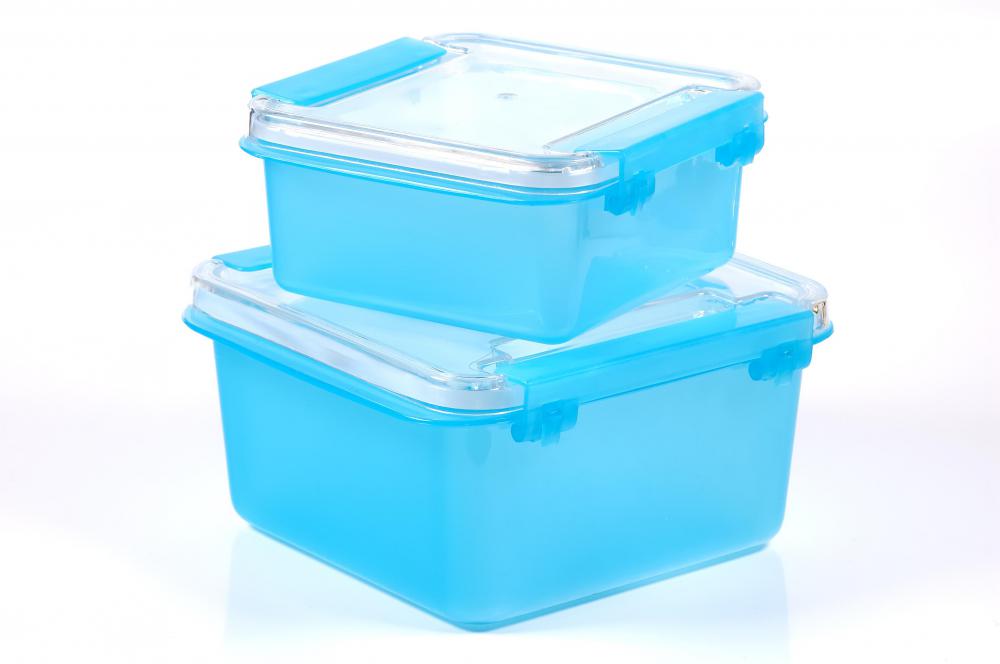At DelightedCooking, we're committed to delivering accurate, trustworthy information. Our expert-authored content is rigorously fact-checked and sourced from credible authorities. Discover how we uphold the highest standards in providing you with reliable knowledge.
What Should I Know About Moldy Bread?
The most important thing to know about moldy bread is that you should not eat it. If mold begins to appear on bread, or most other foods, the food should be discarded and replaced. Much of the structure of mold consists of a mycelium, a delicate network of rootlike structures which can be very difficult to see, which means that even if part of a loaf appears safe to eat, it may be infested with mold.
Some molds that appear on breads are perfectly harmless and safe to eat, but others secrete mycotoxins that can make people sick. Depending on the mold, consuming moldy bread may simply result in a stomach ache, or it could cause more serious health problems. Since identifying molds requires access to a laboratory with a microscope and staining solutions, it's better to simply discard breads which have mold on them, rather than to try and figure out if it is safe. Other foods, like fruits, should also be thrown away if they have begun to mold. The exception to this rule is hard cheese, because the molds that grow on them are usually harmless, so the moldy section can simply be cut off. People who prefer to err on the safe side may want to discard moldy hard cheeses as well.

To slow the rate at which bread molds, you can store it in an airtight container in a cool, dry place. Molds like damp, wet, warm environments, so it's important to make sure that bread has totally cooled after baking to ensure that mold will be less likely develop after it is put into storage. Bread can also be refrigerated or frozen to slow the molding rate.

Homemade, organic, and natural breads tend to become moldy more quickly than commercially produced breads. This is because many bread companies add stabilizers and preservatives to their breads to stave off its growth. The exception to this rule is sourdough, a type of bread that generally does not mold because of the high acidity of the bread.
Bread molds come from a wide variety of genera. Rhizopus stolonifer, or black bread mold, is a type commonly seen in the kitchen, capable of totally covering bread within three days. Some molds are from the Penicillium genus, the same genus used to produce penicillin. If you have access to a laboratory and identification equipment, allowing bread to mold in different environments and identifying the result can be an interesting science project, but be careful. Even when you don't eat it, moldy bread can make you sick if you have a compromised immune system or respiratory problems, as the spores of the mold are free-floating in the air.
AS FEATURED ON:
AS FEATURED ON:

















Discussion Comments
For people for whom one loaf of bread is already too much to eat by themselves, put one half in the freezer!
Thanks, didn't know not to eat moldy bread.
I would just like to also warn of another danger when dealing with moldy bread. I knew a man who was a general maintenance man and cleaner in a business. Part of his job was to close and seal dustbin bags and put new ones in the bins in dressing rooms.
He had found a couple of parts of loaves and some sandwiches that had gone moldy. When he bent to close the bag, he pushed the contents down to make it more compact. In doing so, he breathed in spores from the moldy bread. He started to feel unwell some days later, and ended up being extremely ill and in hospital for months.
It took the hospital ages to work out that the illness came from the bread. He could have died. Thanks to the German healthcare system, he survived. Be aware of mold and mold dust.
@Monika - That's a good idea. Sometimes I keep the regular bread I buy in the refrigerator. I don't eat very much bread, so sometimes my bread gets moldy before I have a chance to eat. And there isn't really an option for buying half a loaf.
I really like to buy organic multigrain bread. I think it's a lot better for you than regular store bought bread and it also tastes better. However, as the article said, it can go moldy really, really quickly. I discovered that the hard way the first time I bought a loaf, and I was so upset by how much bread I wasted.
Now, I keep my organic bread in the freezer from the second I bring it home. Then when I want to use it, I just throw it in the toaster. This way, the bread stays good for quite some time, and I don't waste my money.
@sunnySkys - I wouldn't beat yourself up too much, because you probably made your friend feel a lot better, and she didn't get sick.
I used to think that it wasn't a big deal to eat another piece of bread from a loaf that had some mold on it. I think after reading this article, if I see a spot of mold, I'm definitely just going to throw the whole thing away. It's not worth the risk.
A good friend of mine called me a few days ago freaking out because she started eating some bread and then realized it had mold on it. I told her not to worry, and that she would be fine. I figured as long as she hadn't eaten the actual mold, she'd be fine.
However, after reading this article, it seems like there is more to mold than just the spot you can see. It looks like I inadvertently lied to my friend. She could have gotten sick from that bread. Luckily, she didn't, but she totally could have.
@DylanB – You need to wait until it has no heat left in it. I once covered up a pan of bread while it was still warm, and all the condensation from the trapped heat led to the development of mold.
I know that freshly baked bread tastes better than the kind you buy at the store, but it is just so much trouble, and I can't eat it all before it grows mold. I might try freezing half the loaf. That's what I do with the store bought kind, and I just thaw it out when I eat all of the first half.
If you have baked bread and you need to cover it to keep bugs from lighting on it, do you have to wait until it is absolutely cold to cover it, or can you just wait until it is warm instead of hot? I have gnats in my house, and they seem to be attracted to bread. I'm almost afraid to wait too long to cover it up, but I don't want mold to grow on it, either.
Bread is extremely porous. This lets mold spread throughout it really easily. If I see one spot of mold, I toss the whole loaf.
Mold resulted in the death of lots of people centuries ago. I have read that the Salem witch trials were a result of the bizarre behavior of people who had eaten moldy bread.
The mold made them foam at the mouth, dance wildly, and hallucinate, among other things. They appeared to be possessed, so the public freaked out and ordered them to be killed.
Some of them probably died anyway as a result of mold poisoning. So, I think that moldy bread is nothing to take a chance on.
I really wouldn't worry about hard cheeses and mold. Look up how cheese is made.
So how long exactly can you wait to eat something like moldy bread and cheese before it becomes dangerous?
See, I've always just pinched off the moldy parts and thrown them away, and then gone ahead and eaten the bread, cheese, etc.
Is that bad? I've never gotten sick off of it, so I thought that I would be OK, but after reading this I'm a little less sure.
Can you tell me a little more about this topic, specifically what colors and shapes of mold are the most dangerous, and which ones I can go ahead and just pinch off?
Thanks!
Can you tell me under what humidity conditions will bread turn moldy most rapidly? I am thinking about doing a moldy bread science project that sees how different kinds of bread grow different kinds of mold, which ones mold the fastest, etc.
I only have three weeks to do it though (I left the whole thing a little late), so can you tell me what the best tips are for making bread get moldy quickly?
I am going out today to buy ten loaves, so I hope that I can get an answer soon -- thanks!
Ha! Fantastic first sentence. Also very true. I really like how you added a lot more information about it though.
I never even really thought about how many different kinds of bread mold there were, and how they could affect people.
Now the next time I see bread getting moldy, I will definitely be thinking of this article, and remember the moldy bread safety tips I learned here.
Thanks for the information!
Post your comments